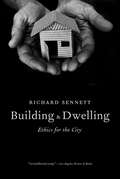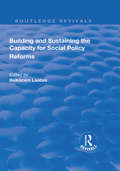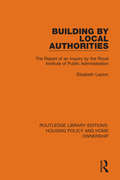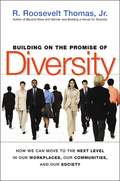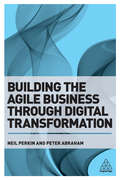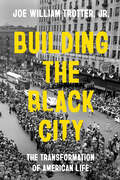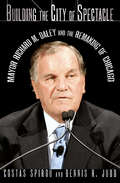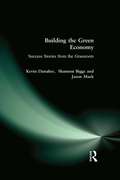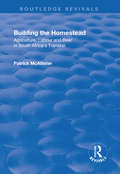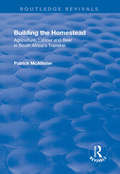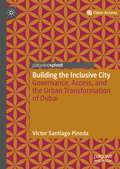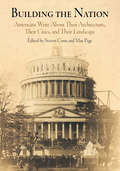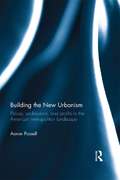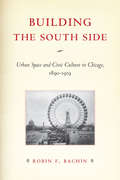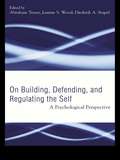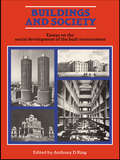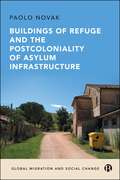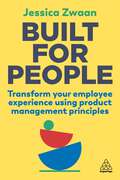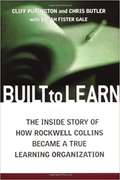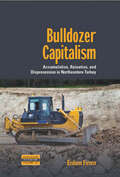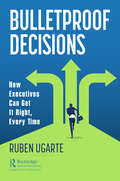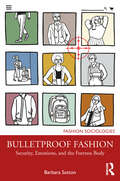- Table View
- List View
Building and Dwelling: Ethics for the City
by Richard SennettA reflection on the past and present of city life, and a bold proposal for its future “Constantly stimulating ideas from a veteran of urban thinking.”—Jonathan Meades, The Guardian In this sweeping work, the preeminent sociologist Richard Sennett traces the anguished relation between how cities are built and how people live in them, from ancient Athens to twenty-first-century Shanghai. He shows how Paris, Barcelona, and New York City assumed their modern forms; rethinks the reputations of Jane Jacobs, Lewis Mumford, and others; and takes us on a tour of emblematic contemporary locations, from the backstreets of Medellín, Colombia, to Google headquarters in Manhattan. Through it all, Sennett laments that the “closed city”—segregated, regimented, and controlled—has spread from the Global North to the exploding urban centers of the Global South. He argues instead for a flexible and dynamic “open city,” one that provides a better quality of life, that can adapt to climate change and challenge economic stagnation and racial separation. With arguments that speak directly to our moment—a time when more humans live in urban spaces than ever before—Sennett forms a bold and original vision for the future of cities.
Building and Sustaining the Capacity for Social Policy Reforms
by Belkacem LaabasThis title was first published in 2000: Ten papers on poverty alleviation and social policy matters applied to Arab countries and Africa. They explore the impact on the vulnerable of the implementation of structural adjustment programmes and look at poverty alleviation and social policies, health care and social security issues.
Building by Local Authorities: The Report of an Inquiry by the Royal Institute of Public Administration
by Elizabeth LaytonOriginally published in 1961, is the report into an investigation of the forms of organization used by local authorities of many varied types, populations and areas for the design and erection of new buildings and the maintenance of existing ones. It discusses the relations between Government departments and local authorities in the control of building design, standards and costs and the part played by Council committees in the control of building operations; it examines the division of functions between Chief Officers responsible for different aspects of building work (architects, engineers, surveyors and housing managers) and studies the use made of private architects and surveyors as well as the scope and organization of direct labour in local authority building.
Building on Borrowed Time: Rising Seas and Failing Infrastructure in Semarang
by Lukas LeyA timely ethnography of how Indonesia&’s coastal dwellers inhabit the &“chronic present&” of a slow-motion natural disaster Ice caps are melting, seas are rising, and densely populated cities worldwide are threatened by floodwaters, especially in Southeast Asia. Building on Borrowed Time is a timely and powerful ethnography of how people in Semarang, Indonesia, on the north coast of Java, are dealing with this global warming–driven existential challenge. In addition to antiflooding infrastructure breaking down, vast areas of cities like Semarang and Jakarta are rapidly sinking, affecting the very foundations of urban life: toxic water oozes through the floors of houses, bridges are submerged, traffic is interrupted. As Lukas Ley shows, the residents of Semarang are constantly engaged in maintaining their homes and streets, trying to live through a slow-motion disaster shaped by the interacting temporalities of infrastructural failure, ecological deterioration, and urban development. He casts this predicament through the temporal lens of a &“meantime,&” a managerial response that means a constant enduring of the present rather than progress toward a better future—a &“chronic present.&” Building on Borrowed Time takes us to a place where a flood crisis has already arrived—where everyday residents are not waiting for the effects of climate change but are in fact already living with it—and shows that life in coastal Southeast Asia is defined not by the temporality of climate science but by the lived experience of tidal flooding.
Building on the Promise of Diversity: How We Can Move to the Next Level in Our Workplaces, Our Communities, and Our Society
by R. ThomasDiversity is the reality of America today. Whether you let diversity be a drain on your organization or a dynamic contributor to your mission, vision, and strategy is both a choice and a challenge. Building on the Promise of Diversity gives you the insights and skills you need to navigate through simmering tensions -- and find creative solutions for achieving cohesiveness, connectedness, and common goals.Building on the Promise of Diversity is R. Roosevelt Thomas’s impassioned wake-up call to bring diversity management to a wholly new level -- beyond finger-pointing and well-meaning “initiatives” and toward the shared goal of building robust organizations and thriving communities. This original, thoughtful, yet action-oriented book will help leaders in any setting -- business, religious, educational, governmental, community groups, and more -- break out of the status quo and reinvigorate the can-do spirit of making things better.The book includes a deeply felt analysis of the sometimes tangled intersections between diversity management and the Civil Rights Movement and affirmative action agendas . . . a personal narrative that charts Thomas’s own evolution in diversity thinking . . . and a roadmap for mastering the powerful craft of Strategic Diversity Management™, a structured process that helps you: * Realize why multiple activities and good intentions are not enough for achieving sustainable progress. * Recast the meaning of diversity as more than just race and gender, but as any set of differences, similarities, and tensions -- such as workplace functions, product lines, acquisitions and mergers, customers and markets, blended families, community diversity, and more.* Accept that a realistic goal is not to eliminate diversity tension but to use it as a catalyst to address key issues. * Recognize diversity mixtures, analyze them accurately, and make quality decisions in the midst of differences, similarities, and tensions.* Build an essential set of diversity skills and develop your “diversity maturity” -- the wisdom, judgment, and experience to use those skills effectively.* Reflect on the ways you might be “diversity challenged” yourself.
Building the Agile Business through Digital Transformation
by Neil Perkin Peter AbrahamBuilding the Agile Business through Digital Transformation is a guide for organizational development professionals and change managers needing to better understand, implement and lead digital transformation in the workplace. It sets aside traditional thinking and outdated strategies to explain what steps need to be taken for an organization to become truly agile. It addresses how to build organizational velocity and establish iterative working, remove unnecessary process, embed innovation, map strategy to motivation and develop talent to succeed. Building the Agile Business through Digital Transformation provides guidance on how to set the pace and frequency for change and shows how to break old habits and reform the behaviours of a workforce to embed digital transformation, achieve organizational agility and ensure high performance. Full of practical advice, case studies, examples and real-life insights from organizational development professionals at the leading edge of digital transformation, this book is an essential guide to building an agile business.
Building the Agile Business through Digital Transformation
by Neil Perkin Peter AbrahamHow can businesses transform to achieve competitive advantage in a digital-enabled world? How can managers and leaders create a culture that supports lasting change through these transformations?Building the Agile Business through Digital Transformation is an in-depth guide for all those needing to better understand, implement and lead digital transformation in the workplace. It sets aside traditional thinking and outdated strategies to explain what steps need to be taken for an organization to become truly agile, embed innovation and develop talent to succeed.This majorly revised second edition of Building the Agile Business through Digital Transformation contains new material on the culture and mindset challenges of shifting at scale from linear to agile working, and using data effectively in organizational decision-making. Full of practical advice, examples and real-life insights from organizations at the leading edge of digital transformation including AirBnb, Amazon and Google, this book is an essential guide to driving success by becoming an agile and digital native business.
Building the Black City: The Transformation of American Life
by Joe William Trotter Jr.A new way of seeing Black history—the sweeping story of how American cities as we know them developed from the vision, aspirations, and actions of the Black poor. Building the Black City shows how African Americans built and rebuilt thriving cities for themselves, even as their unpaid and underpaid labor enriched the nation's economic, political, and cultural elites. Covering an incredible range of cities from the North to the South, the East to the West, Joe William Trotter, Jr., traces the growth of Black cities and political power from the preindustrial era to the present. Trotter defines the Black city as a complicated socioeconomic, spiritual, political, and spatial process, unfolding time and again as Black communities carved out urban space against the violent backdrop of recurring assaults on their civil and human rights—including the right to the city. As we illuminate the destructive depths of racial capitalism and how Black people have shaped American culture, politics, and democracy, Building the Black City reminds us that the case for reparations must also include a profound appreciation for the creativity and productivity of African Americans on their own behalf.Cities covered: Charleston, Savannah, New Orleans, Washington, D.C., Baltimore, Richmond, Birmingham, Durham, Atlanta, Houston, Miami, Tulsa, early New York (New Amsterdam), Philadelphia, Boston Chicago, Detroit, Milwaukee, Cleveland, Cincinnati, Pittsburgh, San Francisco Bay Area, Los Angeles, and Seattle
Building the City of Spectacle: Mayor Richard M. Daley and the Remaking of Chicago
by Dennis R. Judd Costas SpirouBy the time he left office on May 16, 2011, Mayor Richard M. Daley had served six terms and more than twenty-two years at the helm of Chicago’s City Hall, making him the longest serving mayor in the city’s history. Richard M. Daley was the son of the legendary machine boss, Mayor Richard J. Daley, who had presided over the city during the post–World War II urban crisis. Richard M. Daley led a period of economic restructuring after that difficult era by building a vibrant tourist economy. Costas Spirou and Dennis R. Judd focus on Richard M. Daley’s role in transforming Chicago’s economy and urban culture.The construction of the "city of spectacle" required that Daley deploy leadership and vision to remake Chicago’s image and physical infrastructure. He gained the resources and political power necessary for supporting an aggressive program of construction that focused on signature projects along the city’s lakefront, including especially Millennium Park, Navy Pier, the Museum Campus, Northerly Island, Soldier Field, and two major expansions of McCormick Place, the city’s convention center. During this period Daley also presided over major residential construction in the Loop and in the surrounding neighborhoods, devoted millions of dollars to beautification efforts across the city, and increased the number of summer festivals and events across Grant Park. As a result of all these initiatives, the number of tourists visiting Chicago skyrocketed during the Daley years.Daley has been harshly criticized in some quarters for building a tourist-oriented economy and infrastructure at the expense of other priorities. Daley left his successor, Rahm Emanuel, with serious issues involving a long-standing pattern of police malfeasance, underfunded and uneven schools, inadequate housing opportunities, and intractable budgetary crises. Nevertheless, Spirou and Judd conclude, because Daley helped transform Chicago into a leading global city with an exceptional urban culture, he also left a positive imprint on the city that will endure for decades to come.
Building the Green Economy: Success Stories from the Grassroots
by Kevin Danaher Shannon Biggs Jason MarkAfter centuries of economic activity based on extraction, exploitation, and depletion, we now face undeniable environmental threats. New business models that save or restore natural resources are critical. But how can we translate that insight into more sustainable practices?Building the Green Economy shows how community groups, families, and individual citizens have taken action to protect their food and water, clean up their neighborhoods, and strengthen their local economies. Their unlikely victories—over polluters, unresponsive bureaucracies, and unexamined routines—dramatize the opportunities and challenges facing the local green economy movement.Drawing on their extensive experience at Global Exchange and elsewhere, the authors also:Lay out strategies for a more successful green movementDescribe how communities have protected their victories from legal and political challengesProvide key resources for local activistsInclude conversations with Rocky Anderson, Lois Gibbs, Anuradha Mittal, David Morris, Michael Shuman, and other activists and leaders.
Building the Homestead: Agriculture, Labour and Beer in South Africa's Transkei (African Studies From The Netherlands Ser. #Vol. 16)
by P. McAllisterThis title was first published in 2001. "This is also a study of rural Xhosa identity and community, and its survival in the face of the overwhelming odds stacked against it by colonialism and apartheid. The maintenance of homestead production can be properly understood only if this wider context is taken into consideration. The analysis is thus directly relevant to current debates about agrarian change, land reform and economic development in South Africa's communal areas, since it shows how some rural Xhosa are able to maintain a sense of community and identity, and of how they are able to harness the socio-cultural resources at their disposal to engage in productive activity, with some success."--BOOK JACKET.
Building the Homestead: Agriculture, Labour and Beer in South Africa's Transkei (Routledge Revivals #Vol. 16)
by P. A. McAllisterThis title was first published in 2001. "This is also a study of rural Xhosa identity and community, and its survival in the face of the overwhelming odds stacked against it by colonialism and apartheid. The maintenance of homestead production can be properly understood only if this wider context is taken into consideration. The analysis is thus directly relevant to current debates about agrarian change, land reform and economic development in South Africa's communal areas, since it shows how some rural Xhosa are able to maintain a sense of community and identity, and of how they are able to harness the socio-cultural resources at their disposal to engage in productive activity, with some success."--BOOK JACKET.
Building the Inclusive City: Governance, Access, and the Urban Transformation of Dubai
by Victor Santiago PinedaThis Open Access book is an anthropological urban study of the Emirate of Dubai, its institutions, and their evolution. It provides a contemporary history of disability in city planning from a non-Western perspective and explores the cultural context for its positioning. Three insights inform the author’s approach. First, disability research, much like other urban or social issues, must be situated in a particular place. Second, access and inclusion forms a key part of both local and global planning issues. Third, a 21st century planning education should take access and inclusion into consideration by applying a disability lens to the empirical, methodological, and theoretical advances of the field. By bridging theory and practice, this book provides new insights on inclusive city planning and comparative urban theory. This book should be read as part of a larger struggle to define and assert access; it’s a story of how equity and justice are central themes in building the cities of the future and of today.
Building the Nation
by Steven Conn Max PageMoving away from the standard survey that takes readers from architect to architect and style to style, Building the Nation: Americans Write About Their Architecture, Their Cities, and Their Landscape suggests a wholly new way of thinking about the history of America's built environment and how Americans have related to it. Through an enormous range of American voices, some famous and some obscure, and across more than two centuries of history, this anthology shows that the struggle to imagine what kinds of buildings and land use would best suit the nation pervaded all classes of Americans and was not the purview only of architects and designers. Some of the nation's finest writers, including Mark Twain, W. E. B. Du Bois, Henry James, Edith Wharton, Lewis Mumford, E. B. White, and John McPhee, are here, contemplating the American way of building. Equally important are those eloquent but little-known voices found in American newspapers and magazines which insistently wondered what American architecture and environmental planning should look like. Building the Nation also insists that American architecture can be understood only as both a result of and a force in shaping American social, cultural, and political developments. In so doing, this anthology demonstrates how central the built environment has been to our definition of what it is to be American and reveals seven central themes that have repeatedly animated American writers over the course of the past two centuries: the relationship of American architecture to European architecture, the nation's diverse regions, the place and shape of nature in American life, the design of cities, the explosion of the suburbs, the power of architecture to reform individuals, and the role of tradition in a nation dedicated to being perennially young.
Building the New Urbanism: Places, Professions, and Profits in the American Metropolitan Landscape
by Aaron PassellThe New Urbanism is perhaps the most influential movement that has emerged in suburban design, planning, and development in recent decades. It proposes to reform conventional suburban development by "building community." Building the New Urbanism asks "why new urbanism now?" to provide the first in-depth sociological investigation of the emergence of this phenomenon. This volume situates the growth of New Urbanism in the history of urban and suburban policy and development. The book builds an account of the movement’s founding and development, linking its progress to the making of new places. The volume also investigates how the movement capitalized upon dynamics within architecture, planning, and the homebuying public to recruit support from among those groups. The book establishes a framework for analyzing the opportunities and constraints that confront any effort to change the way we produce the built environment. Moreover, it reveals how elaborately social the production of the built environment is and how specific the material solutions to social conditions must be to resolve this process. Building the New Urbanism is an accessible volume that encapsulates and engages the dominant history of American suburbia. It draws on interviews with key figures, brings the work of prominent theorists of culture and science into the investigation, and broadens the focus of urban studies to the metropolitan region. It will be of particular interest to scholars and students of urban and suburban development, sociology, geography, and planning.
Building the South Side: Urban Space and Civic Culture in Chicago, 1890-1919
by Robin F. BachinBuilding the South Side explores the struggle for influence that dominated the planning and development of Chicago's South Side during the Progressive Era. Robin F. Bachin examines the early days of the University of Chicago, Chicago's public parks, Comiskey Park, and the Black Belt to consider how community leaders looked to the physical design of the city to shape its culture and promote civic interaction. Bachin highlights how the creation of a local terrain of civic culture was a contested process, with the battle for cultural authority transforming urban politics and blurring the line between private and public space. In the process, universities, parks and playgrounds, and commercial entertainment districts emerged as alternative arenas of civic engagement.
Building the Team Organization
by Dean Tjosvold Mary TjosvoldIs your organization a true team or merely a collection of individuals more or less pulling in the same direction? Much as we might wish it, none of us can reach our goals without the help of others in our organization – and they need us to help them to achieve theirs. This interdependence is a basic characteristic of organizations, yet it is only recently that managers, professionals, and employees have begun to appreciate the extent to which organizational success depends upon teamwork. This book provides a concise and powerful understanding of productive teamwork in organizations, with a practical model for developing methods and approaches for successful collaboration. Readers can understand and see how they can work together effectively with their colleagues, leaders, and organizational partners.
Building, Defending, and Regulating the Self: A Psychological Perspective
by Abraham Tesser Joanne V. Wood Diederik A. StapelThis volume pulls together research on several aspects of the self. One set of chapters deals with the importance of building a self based on authenticity and "Who I really am."; a second group deals with the ways in which we defend views of the self as positive and powerful; a third group is concerned with multiple aspects of self regulation. Each of the chapters is a well-written, non-technical description of an important, currently active research program.
Buildings and Society: Essays on the Social Development of the Built Environment
by Anthony D. KingFirst Published in 1984. Routledge is an imprint of Taylor & Francis, an informa company.
Buildings of Refuge and the Postcoloniality of Asylum Infrastructure (Global Migration and Social Change)
by Paolo NovakThis book offers a fresh perspective on the European migration crisis, chronicling its everyday realities in a central Italian province. Through vivid ethnographic accounts, it reveals how the forces and relations animating this crisis are reproduced and transformed in the rooms of ordinary buildings converted into shelters for asylum seekers. Drawing on postcolonial and feminist approaches, the author explores the intersection of global and local histories, migrant stories and bordering processes, providing a timely lens for understanding migration today. This is an invaluable contribution to debates on EU borders, including their logistical management, their coloniality and the autonomous force of migration that subverts them.
Built for People: Transform Your Employee Experience Using Product Management Principles
by Jessica ZwaanTaking the best elements of a product-management approach and applying them to HR activity can transform the people function. This book shows you how. Written for all HR professionals and business leaders, Built for People explains how to improve workforce and business performance by developing people-centred ways of working, evidence-based decision making and a culture of continuous feedback and iteration. It explains everything from what this approach means for business professionals, what the benefits of it are and how to do it effectively. It covers how to proactively develop an employee experience which attracts, engages and retains the talent the business needs and supports them to operate at their full potential. There is also practical guidance on the importance of user research, sprint planning, vision development and how to encourage a continuous feedback loop in your team.This book includes the importance of testing and iteration and how to define metrics for success, as well as showing you how to handle organizational change, company culture clashes and how to build and improve overall business performance and employee experience at scale. Full of tools, case studies, exercises and advice from those who are already seeing the benefits of a product-management approach, this is essential reading for all business leaders needing to develop an agile, innovative and evidence-based approach to their people operations.
Built to Learn: The Inside Story Of How Rockwell Collins Became A True Learning Organization
by Chris Butler Cliff Purington Sarah Fister GaleAerospace giant Rockwell Collins typified the old-fashioned corporate approach to organizational learning: lackluster offerings in bland classroom settings, with little connection to the needs of employees or the goals of the company. Enter Cliff Purington and Chris Butler, who in three years transformed Rockwell into a full-fledged learning organization. With a strategy-based and technology-driven learning approach, a 400 percent increase in offerings, 24/7 access for 17,000 worldwide employees, and cost savings of $23 million, Rockwell is lauded and emulated by organizations all over the world. For this vital book, Purington and Butler have organized their revolutionary approach into 10 clear steps that can similarly transform any company. Readers will learn new ways to build relationships, define core learning objectives, present a solid business case, and implement programs and assess their value. Each step offers detailed processes to follow, and explains what worked (and what didn’t), revealing the secrets behind Rockwell’s stunning transformation.
Bulldozer Capitalism: Accumulation, Ruination, and Dispossession in Northeastern Turkey (Dislocations #31)
by Erdem EvrenSet in the resource frontier of northeastern Turkey, Bulldozer Capitalism studies the rise and decline of an anti-dam/anti-displacement campaign and the political responses to other extractive projects that it helped to shape in its aftermath. The book shows that people can accommodate their own dispossession and displacement if they are directed to negotiate, invest in, and speculate on the destruction of their built environment and nature, and their material and immaterial bonds, wealth, and activities.
Bulletproof Decisions: How Executives Can Get It Right, Every Time
by Ruben UgarteWe are told from a young age that we should strive to make the right decisions, but we aren’t taught exactly how to do this. Every day, we make over 35,000 decisions in our personal and professional lives. How many of those decisions do we get right? This book will help business executives systematically tackle these 35,000 decisions. Executives are forced to make critical decisions that impact their lives, their employees’ lives, and the lives of their customers. Decisions like what products to create, who should be hired, and what divisions to shut down are all commonplace in the executive suite. This book offers three strategies for dealing with decisions: problem-solving techniques, routines, and decision-making frameworks. Each strategy is designed to help readers achieve more clarity, gain time back, and improve the quality of their decisions. The first one focuses on helping readers solve the right problem instead of wasting time on the wrong one. The second strategy helps deal with decisions that need to be made once but can then be executed regularly. The third and final strategy provides a three-step framework for making the most important decisions in their lives. The focus of the author’s work is on helping readers use data to make better decisions. This book gives readers the tools to convert the insights they learn from their data into actionable decisions.
Bulletproof Fashion: Security, Emotions, and the Fortress Body (Fashion Sociologies)
by Barbara SuttonIn the context of gun proliferation and persistent gun violence in the United States, a controversial security strategy has gained public attention: bulletproof fashion. This book examines concerns about security focusing on armored clothing and accessories for civilians. Available for children and adults, such ballistic products include colorful backpacks, elegant suits, sports jackets, feminine dresses, trendy vests, and medical lab coats. These products are paradigmatic of a "fashion of fear"—the practice of outfitting the body with apparel aimed at maximizing personal security. This fashion encourages the emergence of both a fortress body and an armored society. Sutton also explores the wider social factors influencing the bulletproof fashion phenomenon, including the inequalities associated with neoliberalism and the militarization of civilian life. The book sheds light on the role of emotions in relation to discourses and perceptions of security, and encourages feminist and sociological studies to pay attention to the linkages between security, bodies, and dress. It is ideal for students and scholars interested in security and gun violence, culture and politics, neoliberalism and consumption, and bodies and emotions.
